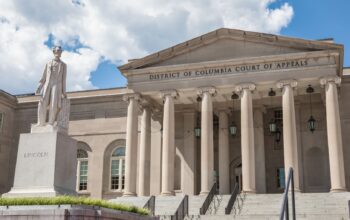by Charlene Crowell, Special to The Informer
In 2023, “March Madness” took on a new meaning. Traditionally known as the nation’s premier college basketball competition, this year that moniker could also describe the madness that sprang from the closure of two banks with combined assets of $322 billion that affected consumers and small businesses in over 15 states.
Silicon Valley Bank (SVB), established in 1983, grew its operations to 15 states by 1996 — from California to New York, north to Washington state to as far south as Texas and Florida. In December 2022, its assets totaled $212 billion and the bank employed over 8,500 people.
But on March 8 in an attempt to improve its own liquidity, SVB instead incurred a $1.8 billion loss. The next business day, a run of bank withdrawals totaled $40 billion. And on March 10, SVB was forced to close and became the second-largest bank failure since Washington Mutual in 2008.
Similarly, Signature Bank, founded in 2001 as a commercial bank headquartered in New York City, grappled with its own problems that also led to a March closure. Signature Bank had 40 branches and 1,800 employees throughout the New York metropolitan area, Connecticut, North Carolina, California and Nevada, in addition to its online banking services. In December 2022, the bank had assets of $110.4 billion and total deposits of $88.6 billion.
Only days after SVB’s closure, Signature, with heavy concentrations of investments in private equity ($28 billion in loans) and commercial businesses like cryptocurrency, experienced its own $10 billion run on deposits. With an estimated 90 percent of its deposits uninsured, according to Barron’s, Signature’s stock dropped 50 percent. On March 12, it was forced to close, and became the third-largest bank failure in the nation since 2008.
Many might wonder how costly bank failures could occur when 2008’s Dodd-Frank Wall Street Reform and Consumer Protection Act was created to prevent such financial calamities.
Congressional leaders want answers to that question.
“[T]hese events are a wakeup call,” said Maxine Waters, a California Congresswoman and Ranking Member of the House Financial Services Committee. “We must uncover how management, regulatory, and supervisory failures contributed to these events and explore solutions to strengthen the safety and soundness of our banks. Small business owners should not be expected to serve as a financial regulator when paying their employees, and community banks and minority depository institutions should not have to pay for the failures of bank mismanagement at SVB or Signature Bank.”
Rep. Waters also decried efforts to shift blame for the collapse from bank management and panicked investors onto so-called “woke” capitalism, as signified by the presence of one person of color on the board of directors of Silicon Valley Bank. “Silicon Valley Bank collapsed because of management failures and possible regulatory weaknesses – not because there was one Black man on the board,” said Rep. Waters. “We saw this same racist playbook during the 2008 financial crisis when some Republicans blamed the Community Reinvestment Act and loans made to people of color.”
Senator Sherrod Brown of Ohio, chair of his chamber’s Banking Committee, shared similar concerns.
“In less than a day, Silicon Valley Bank customers pulled $42 billion out of the bank – fueled by venture capitalists and their social media accounts,” said Sen. Brown. “They created the largest and fastest bank run in history. In the following days, Signature Bank lost $17.8 billion.”
After noting that Silicon Valley Bank’s executive pay was tied to profits and the bank operated without a risk officer for more than a year, Chairman Brown pointed the proverbial financial finger at the bank executives who took on high risk that fed their collective greed.
“Wealthy elites do anything to make a quick profit and pocket the rewards. And when their risky behavior leads to catastrophic failures, they turn to the government asking for help, expecting workers and taxpayers to pay the price.”
Michael Barr, who testified before Senate Banking on March 28, testified on behalf of the Federal Reserve System’s Board of Governors, as its vice chair for supervision. Calling for transparency and full accountability with recent bank failures, Barr announced an investigative report on supervisory assessments and exam materials would be made public by May 1.
“SVB failed because the bank’s management did not effectively manage its interest rate and liquidity risk, and the bank then suffered a devastating and unexpected run by its uninsured depositors in a period of less than 24 hours,” testified Barr. “SVB’s failure demands a thorough review of what happened, including the Federal Reserve’s oversight of the bank.”
Speaking before the National Association for Business Economics on March 30, Treasury Secretary Janet Yellen weighed in on the recent closures:
“When the President and I took office in January 2021, we inherited a financial stability apparatus at Treasury that had been decimated,” said Yellen. “Over the past two years, I have made it a top priority to rebuild the financial stability infrastructure at Treasury.”
“Our prosperity depends on the work to safeguard financial stability before a crisis occurs – just as the implementation of a strong fire code can prevent a fire from breaking out,” concluded Yellen.
Consumers and small businesses affected by these closures are urged by the Federal Deposit Insurance Corporation (FDIC) to remain watchful of scams and frauds. These scams often begin by seeking personal information while posing as representatives from Signature Bank, Signature Bridge Bank, N.A., or the FDIC.
More related information is available online: http://www.fdic.gov/resources/resolutions/bank-failures/failed-bank-list/. A 24-hour toll-free call center is also available by dialing: 1-866-744-5463.
Source: Published without changes from Washington Informer Newspaper



